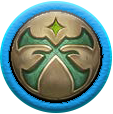
Geobukseon Retaliation [reaction] Feat 10Uncommon Fire Inventor Modification Unstable Source Tian Xia Character Guide pg. 111Access Tian Xia origin
Trigger You would take damage.
Your armor has a retractable spike-covered shell reminiscent of Hwanggot’s heavily armored geobukseon, or “turtle ships.” The shell unfolds across your body, giving you a +4 circumstance bonus to AC and
resistance 2 to bludgeoning, piercing, and slashing damage until the end of your next turn. Spiked chains propelled by small bursts of black powder also erupt from the shell, dealing 3d4 piercing damage plus 2
persistent fire damage (basic Reflex save against your class DC) to all creatures in a 5-foot
emanation.
Traits
Fire: Effects with the fire trait deal fire damage or either conjure or manipulate fire. Those that manipulate fire have no effect in an area without fire. Creatures with this trait consist primarily of fire or have a connection to magical fire.
Planes with this trait are composed of flames that continually burn with no fuel source. Fire planes are extremely hostile to non-fire creatures. Unprotected wood, paper, cloth, and other flammable materials catch fire almost immediately, and creatures wearing unprotected flammable clothing catch fire, typically taking 1d6 persistent fire damage. Extraplanar creatures take moderate environmental fire damage at the end of each round (sometimes minor environmental damage in safer areas, or major or massive damage in even more fiery areas). Ice creatures are extremely uncomfortable on a fire plane, assuming they don’t outright melt in the heat.
Modification: A feat with this trait alters the construction of your innovation. If you have the reconfigure class feature, you can retrain such a feat more easily
Uncommon: Something of uncommon rarity requires special training or comes from a particular culture or part of the world. Some character choices give access to uncommon options, and the GM can choose to allow access for anyone. Less is known about uncommon creatures than common creatures. They typically can't be summoned. The DC of Recall Knowledge checks related to these creature is increased by 2.
Unstable: Unstable actions use experimental applications of your innovation that even you can't fully predict, and that are hazardous to your innovation (and potentially you). When you take an unstable action, attempt a DC 15 flat check immediately after applying its effects. On a failure, the innovation malfunctions in a spectacular (though harmless) fashion, such as a belch of smoke or shower of sparks, and it becomes incapable of being used for further unstable actions. On a critical failure, you also take an amount of fire damage equal to your level. As the innovation's creator, you can spend 10 minutes retuning your innovation and making adjustments to return it to functionality, at which point you can use unstable actions with that innovation again.
To take an unstable action, you must be using your innovation (for example, wearing an armor innovation or wielding a weapon innovation). If you have a minion innovation, some unstable actions are taken by the minion instead of you. In these cases, only the minion can take that action, and the minion needs to have been Commanded that turn to take the action. If you critically fail the flat check, the minion takes the damage instead of you.
Some actions have an Unstable Function entry, which you can use to add the unstable trait for a bigger benefit. If you're unable to use unstable actions, you can still use the action normally, but you can't use the unstable function.